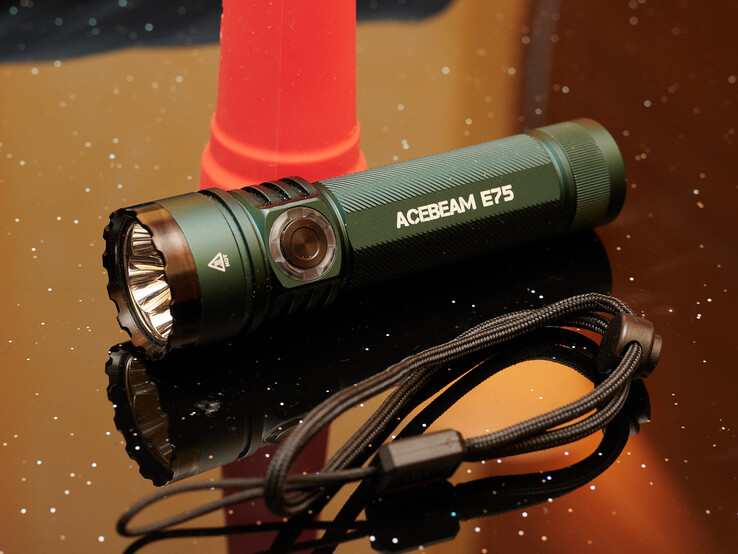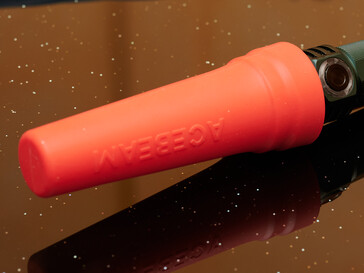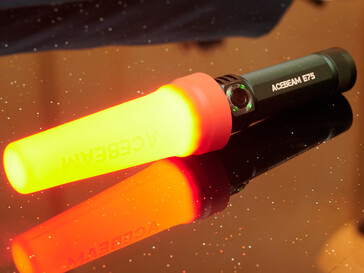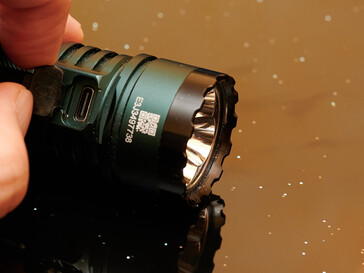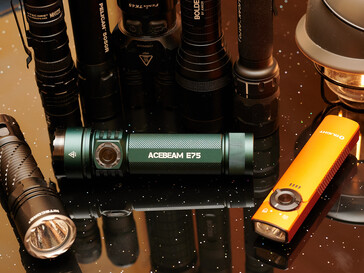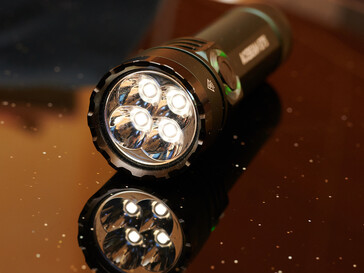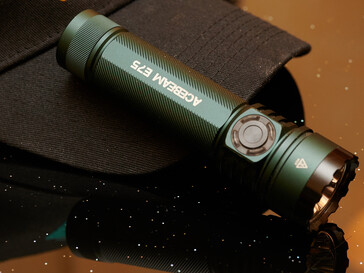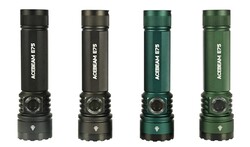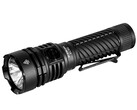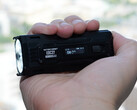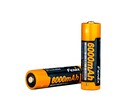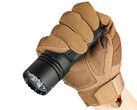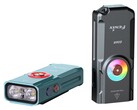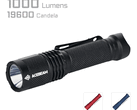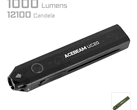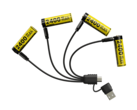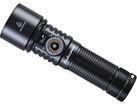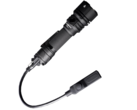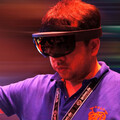Acebeam E75 hands-on: Powerful but heavy EDC flashlight
Acebeam's E75 is a flashlight that is sold as a classic Everyday Carry (EDC). We tested the high-lumen version, which produces up to 4,500 lumens. Alternatively, there is also a variant with a high color rendering index of 90, which we did not test.
It is therefore primarily intended for everyday use and is also easy to operate. Press the button once and it switches on. If you then hold the button down, it switches through the various light modes from 50 to 1500 lumens.
However, three of these are not available this way. For example, there is the particularly weak moonlight mode. The four light sources in the head then emit just one lumen. However, the flashlight lasts for weeks. In absolute darkness, you still have a minimum of light even in an emergency. This is activated by pressing and holding the button when switching on.
Turbo mode, on the other hand, requires a double-click - regardless of whether the E75 is on or off. Strobe mode can be accessed with a triple click, which is also a defense mode because you don't want to look into this light. It is very unpleasant.
Magnets on the back
Acebeam's E75 also has other conveniences. The magnet on the back is practical, so the flashlight can be quickly attached anywhere. The magnet is also strong enough to place the 217-gram E75 anywhere, even crosswise. Glass magnetic surfaces are an exception - these require extremely strong magnets. However, this is a weakness of these glass surfaces and not a weakness of the E75.
Incidentally, the flashlight can also be positioned very well thanks to the flat back. In normal mode, it is powerful enough to illuminate a 20 square meter room by simply pointing it towards the ceiling and indirectly illuminating the room.
Accessories are also available for the E75. For around 2 euros, the company sells a Traffic Wand, for example, which turns the flashlight into a light stick. This is made from a flexible rubber material. This is practical because you don't have to worry about the accessories breaking in the tightly packed bag. Nitecore also has such options, but they are made of hard plastic. With the competition, you have to be careful when packing.
Anyone who wants to instruct someone with the flashlight will like it, especially as the illumination of the Traffic Wand is surprisingly uniform. The Traffic Wands in white or red are unfortunately not available everywhere. However, if you see them when shopping, you should simply order them - they are definitely worth one or two euros.
The flashlight also has a holder that can be used on both sides so that it can be clipped onto a belt, for example. Double-sided means that it can be used in both directions when clipped in. This is important for attaching the flashlight to a cap, for example. However, we have to qualify this right away. The E75 is too heavy for this. The risk of the cap slipping off your head is quite high.
Boost mode for exceptional cases
Boost mode is implemented a bit like in the Olight Arkfeld, which we tested. On paper it's nice, but in practice, it's only useful if you have an eye on the battery capacity. Unfortunately, the battery indicator does not show whether the turbo or strobe mode is also available. It's a shame, as the four LEDs would have been ideal for a battery indicator.
Instead, you simply have to try out which mode works. If a mode cannot be called up, it means that the battery is too weak. If the battery is also almost empty, it can happen that switching through the modes no longer works. However, to achieve this in practice you need to use the flashlight for a very long time or not look at the battery for a long time.
Heat development and LED design
To create the light output, Acebeam uses a design that bundles four LEDs in a square. We can reassure anyone who fears that the light cone might not have a corresponding shape. The cone of light produced is very uniform. Although this is rather unimportant in a forest or similar setting. Acebeam has done a great job here.
A problem with the design: in turbo mode, the flashlight can get very hot - painfully hot. In our measurements, at an ambient temperature of around 20 °C, the handle got almost 55 °C hot. This is just about acceptable if you are not too sensitive to heat.
The head reaches over 65 °C after a few minutes of operation. Touching it then becomes painful. The battery is almost fine at 50 °C. It doesn't get all the waste heat but holds it for a relatively long time when the E75 is switched off again, while the head cools down quickly.
Even at relatively low temperatures, turbo mode is only suitable for very short periods of use. If you're out and about on a warm summer night, you'll get even less out of it.
Charging with 11 watts and too long 21700 battery
The USB-C charging proved to be unproblematic in the test. We did not experience any cases where the flashlight did not want to charge. In our tests, the E75 could be charged with a maximum of 11 watts. Considering the size of the battery (18 watt-hours capacity), this is fine.
Too bad: Acebeam does not use the four LEDs on the switch for a capacity display. This can only be seen indirectly. The less light output is activated, the less battery capacity is available.
What is practical is that the E75 can also light up when charging, however, only in moonlight mode or 50-lumen mode. Switching through the light modes does not work when charging.
The battery can of course also be charged externally or replaced. But beware: the 21700 battery from Acebeam is not standard-compliant. It is slightly too long for our 21700 charger and measures almost 7.5 cm. However, we were able to charge the battery in a Nitecore charger, another manufacturer of 21700 batteries that is not so particular about the dimensions.
Of course, this only becomes a problem if you have a fleet of such flashlights. Owning only a single EDC, most people will probably charge the battery directly in the flashlight. If you do remove the battery, you should make sure that the screw cap is correctly tightened when reinserting it. If you do not turn it all the way to the cap, which can quickly happen with the rather high resistance, you will not be able to switch on the EDC because of the poor contact.
Pro
+ Magnetic holder
+ Simple operation
Contra
- 21700-battery is too long
- Heavy for EDC-L
Verdict
The Acebeam E75 is a good flashlight. However, it must be considered with restrictions. The 4500-lumen mode can only be used for short periods at best. You have to pay far too much attention to ensuring that the battery charge is good, which unfortunately can only be seen indirectly. Irrespective of this, the E75 simply gets too hot in this mode and then slowly reduces the brightness.
Its strengths lie more in the lower to medium range with the Moonlight mode, which is said to last for almost a whole month. The light is, of course, very weak, but the flashlight is always ready to use, especially in emergencies, as the self-discharge was not noticeable, at least in our test.
It is also easy to use in everyday life thanks to its thought-out controls and positioning capabilities, such as the magnetic holder or the flat back. Although, at over 200 grams, it is a surprisingly heavy EDC flashlight that also takes up a lot of space. However, if you are traveling with a backpack, for example, the Acebeam E75 is sure to find a place.
Price and availability
In the US, interested users can easily order Acebeam flashlights via Amazon.
Transparency
The selection of devices to be reviewed is made by our editorial team. The test sample was given to the author by the manufacturer free of charge for the purposes of review. There was no third-party influence on this review, nor did the manufacturer receive a copy of this review before publication. There was no obligation to publish this review. As an independent media company, Notebookcheck is not subjected to the authority of manufacturers, retailers or publishers.
This is how Notebookcheck is testing
Every year, Notebookcheck independently reviews hundreds of laptops and smartphones using standardized procedures to ensure that all results are comparable. We have continuously developed our test methods for around 20 years and set industry standards in the process. In our test labs, high-quality measuring equipment is utilized by experienced technicians and editors. These tests involve a multi-stage validation process. Our complex rating system is based on hundreds of well-founded measurements and benchmarks, which maintains objectivity. Further information on our test methods can be found here.




